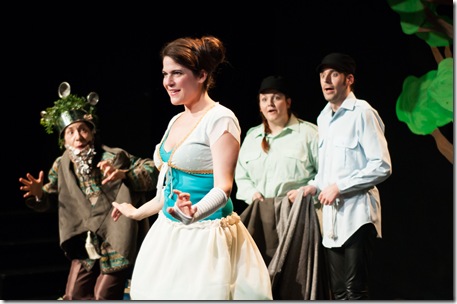The Projet Turandot by Marc LeMyre: Théâtre du Tremplin’s production raises a lot of questions.
The play, written by the Toronto based author Marc LeMyre and directed by Benoit Roy who is the current director of the Théâtre Tremplin in Ottawa, was loosely inspired by Carlo Gozzi’s fable (Turandotte – 1762). Puccini’s opera was adapted from Gozzi’s version about the cruel Chinese princess, who beheads her suitors to avenge herself on men for killing an ancestor but actually the legend of Turandot has nothing to do with China. It was originally Persian. As for the Théâtre Tremplin, it is one of the rare Francophone community theatres in the Ottawa area, based in Ottawa east. It is a training ground for francophones who later move on to become involved in the established professional franco-ontarian companies in the area. They usually invite a well-known director from outside the company and their work has been extremely good in the past.
This is a remounting of a play that was first produced in 2001 by Ottawa’s La Catapulte and judging from the performance last night at the Studio Léonard Beaulne, it’s the play, not the production that has some problems because the performances were all fine. In the first place it is not clear to whom this work is addressed. It resembles a world of eccentric make- believe with childlike shapes and colours as the basis of the scenography where the princess Turandot and her “playmate” Mandarine” cavort together in glee. The costumes seemed like a collage of styles that young people would throw together after opening an old trunk in the attic of their parents’ house. An imaginative free for all in a fantasy world, penetrated by strange trees, splashes of colour and sounds . There is also a gnarled old king as well as a 153 year old wise man puffing on his hookah as he sits up on the branch of a tree, looking like the cross between the smoking caterpillar in Alice in Wonderland, the grinning Cheshire cat and a genie fresh out of a bottle. The Princess and her suitor Calaf have a naïve childlike quality about them that a young person could appreciate but at the same time, the story and many of the references are not at all for youngsters and at times, it even feels like a descent into the subconscious of a young girl confronted with realites that are too upsetting to deal with.
The atmosphere in that fantasy world moves towards the sinister and threatening, a feeling emphasized by the choice of music that added much to the atmosphere. Princess Turandot is pregnant which is a serious question for teenagers. The Old king, Turandot’s father , wants his daughter to get married and have babies to populate his regime. In fact there are images of these wrinkled old men eyeing nice young nubile girls as machines for making children in order to perpetuate the regime. Something is not quite Kosher about all this and certainly not for young children especially when we learn that Turandot became pregnant in a near rape situation.
As well, in this confused world of sinister childish games, questions of sexual identity are toyed with in a fun-filled way that is very good but suddenly jealousy raises its ugly head as the aspiring suitor and husband , the Calaf, clashes with “Mandarine”, Turandot’s servant, playmate, androgynous close friend and ambiguous companion, in a relationship which does not dare to speak its name but that might cause some confusion for young people. Turandot is going to have twins the birth scene is both naïve and less than funny as the babies are represented warming themselves in mommy’s oven, a small cupboard. In this space, before the birth, they discuss their relationship as brother and sister and their living conditions as the scene takes us back to Woody Allen’s fantasy entitled All you ever wanted to know about sex but were afraid to ask,. At the same time, these little unborn creatures throw us completely off track because they looked something like condoms or sausages, or bags with little faces popping out of them. The costume designer didn’t quite get that one right!
As for the language, it was an interesting mixture of word plays, references to popular culture, twisting of pat expressions where the vocabulary is misplaced to create new meanings and a carnival of textual games that were enticing to hear but certainly not for children.
For me, the substance of this Project Turandot – which strays very far from Turandot – had little to hold my interest except for the explosion of language games which played with my head and provoked the odd laugh from time to time. It was not clear what this team was trying to accomplish with this but it looked like a singular stage adventure that engaged all the actors, who were very good indeed. That is no doubt, enough to justify such a production.
The PROJET TURANDOT continues until this Saturday evening in the Léonard Beaulne Studio , 135 Séraphin Marion, Starts at 19h00 and a good understanding of French is vital!
Projet Turandot by Marc LeMyre, loosely adapted from Gozzi
Directed by Benoit Roy
Scenography and props: Andrée- Eve Archambault
Sound: Venessa Lachance
Costumes: Annie Cloutier
Lighting: Mario Belisle.
Cast:
Turandot: Chantal Tokarsky
Mandarine: Catherine Caron
Radium: Tania St-Jean
Médium: Marc-André Tessier
Calaf : Sylvain Sabatié
Le Sage : Nicolas Tremblay-Foisy
